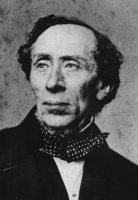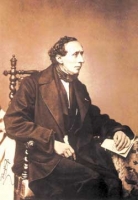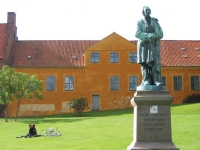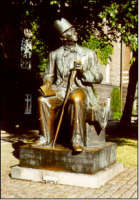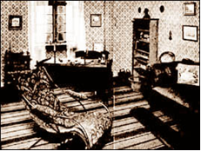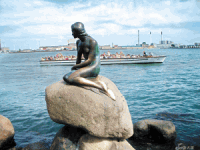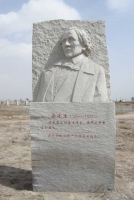ān tú shēng zhōng shēng wèi chéng jiā shì, 1875 nián 8 yuè 4 rì bìng shì yú péng yǒu héng héng shāng rén mài 'ěr qiáo jiā zhōng。
ān tú shēng wén xué shēng yá shǐ yú 1822 nián。 zǎo qī zhù yào zhuàn xiě shī gē hé jù běn。 jìn rù dà xué hòu, chuàng zuò rì qū chéng shú。 céng fā biǎo yóu jì hègē wǔ xǐ jù, chū bǎn shī jí hèshī jù。 1833 nián chū bǎn cháng piān xiǎo shuō《 jí xīng shī rén》, wèitā yíng dé guó jì shēng yù, shì tā chéng rén wén xué de dài biǎo zuò。
“ wèile zhēng qǔ wèi lái de yī dài ”, ān tú shēng jué dìng gěi hái zǐ xiě tóng huà, chū bǎn liǎo《 jiǎng gěi hái zǐ men tīng de gù shì》。 cǐ hòu shù nián, měi nián shèng dàn jié dū chū bǎn yī běn zhè yàng de tóng huà jí。 qí hòu yòu bù duàn fā biǎo xīn zuò, zhí dào 1872 nián yīn huàn 'ái zhèng cái zhú jiàn gē bǐ。 jìn 40 nián jiān, gòng jì xiě liǎo tóng huà 168 piān。
ān tú shēng tóng huà jù yòu dú tè de yì shù fēng gé: jí shī yì de měi hé xǐ jù xìng de yōu mò。 qián zhě wéi zhù dǎo fēng gé, duō tǐ xiàn zài gē sòng xìng de tóng huà zhōng, hòu zhě duō tǐ xiàn zài fěng cì xìng de tóng huà zhōng。
ān tú shēng de chuàng zuò kě fēn zǎo、 zhōng、 wǎn sān gè shí qī。 zǎo qī tóng huà duō chōng mǎn qǐ lì de huàn xiǎng、 lè guān de jīng shén, tǐ xiàn xiàn shí zhù yì hé làng màn zhù yì xiāng jié hé de tè diǎn。 dài biǎo zuò yòu《 dǎ huǒ xiá》、《 xiǎo yì dá de huā 'ér》、《 mǔ zhǐ gū niàn》、《 hǎi de nǚ 'ér》、《 yě tiān 'é》、《 chǒu xiǎo yā》 děng。 zhōng qī tóng huà, huàn xiǎng chéngfèn jiǎn ruò, xiàn shí chéngfèn xiāng duì zēng qiáng。 zài biān tà chǒu 'è、 gē sòng shàn liáng zhōng, biǎo xiàn liǎo duì měi hǎo shēng huó de zhí zhe zhuī qiú, yě liú lù liǎo quē fá xìn xīn de yōu yù qíng xù。 dài biǎo zuò yòu《 mài huǒ chái de xiǎo nǚ hái》、《 bái xuě huáng hòu》、《 yǐng zǐ》、《 yī dī shuǐ》、《 mǔ qīn de gù shì》、《 yǎn mù 'ǒu xì de rén》 děng。 wǎn qī tóng huà bǐ zhōng qī gèng jiā miàn duì xiàn shí, zhuólì miáo xiě dǐ céng mín zhòng de bēi kǔ mìng yùn, jiē lù shè huì shēng huó de yīn lěng、 hēi 'àn hé rén jiān de bù píng。 zuò pǐn jī diào dī chén。 dài biǎo zuò yòu《 liǔ shù xià de mèng》、《 tā shì yī gè fèi wù》、《 dān shēn hàn de shuì mào》、《 xìng yùn de bèi 'ér》 děng。
ān tú shēng nián biǎo
1805 nián 4 yuè 2 rì chū shēng yú dān mài fèi 'ēn dǎo 'ào dēng sài xiǎo zhèn。
1816 nián 11 suì shí fù qīn guò shì。
1819 nián 14 suì shí dú zì lí jiā dào gē běn hā gēn, xún qiú chuàng zuò jī huì。
1822 nián 8 yuè fā biǎo zuò pǐn《 cháng shì jí》, hán shī jù jí gù shì gòng sān piān。 cǐ jí zǐ yīn qí chū shēn hán wēi 'ér wú chū bǎn jī huì, dàn yǐ yǐn qǐ wén huà jiè mǒu xiē rén shì de zhù yì。 10 yuè, jìn rù zhōng děng jiào huì xué xiào bǔ xí wén huà, gòng dú liù nián, duì qí jiào yù fāng shì gǎn dào tòng kǔ bù yǐ; bù guò zhè liù nián zhōng dà liàng yuè dú míng jiā zuò pǐn, yě liàn xí chuàng zuò shī piān、 gē jù。 1827 nián, lí kāi xué xiào huí dào gē běn hā gēn。 fā biǎo shī gē, shòu dào shàng liú shè huì píng lùn jiā chēng zàn, gǔ qǐ 'ān tú shēng duì xiě zuò de xìn xīn。
1829 nián, xiě chū cháng piān huàn xiǎng yóu jì《 ā mǎ gé dǎo màn yóu jì》 chū bǎn, dì yī bǎn xiāo shòu yī kōng。 chū bǎn shāng lì kè yǐ yōu hòu tiáo jiàn mǎi xià dì 'èr bǎn, ān tú shēng yīn cǐ cóng jī 'è de yā pò zhōng jiě tuō。 xǐ jù《 zài ní gǔ lā yé fū tǎ shàng de 'ài qíng》 zài huáng jiā gē jù yuàn shàng yǎn。 tóng nián yě chū bǎn dì yī běn shī jí。
1830 nián, chū liàn shī bài。 kāi shǐ lǚ xíng; dì 'èr běn shī jí chū bǎn。
1831 - 1834 nián, liàn 'ài zài dù shī bài, zāo féng mǔ sàng, bù jiǔ chū bǎn cháng piān zìzhuàn tǐ xiǎo shuō《 jí xīng shī rén》。
1835 nián 30 suì shí kāi shǐ xiě tóng huà, chū bǎn dì yī běn tóng huà jí, jǐn 61 yè de xiǎo cè zǐ, nèi hán《 dǎ huǒ xiá》、《 xiǎo kè láo sī hé dà kè láo sī》、《 wān dòu shàng de gōng zhù》、《 xiǎo yì dá de huā 'ér》 gòng sì piān。 zuò pǐn bìng wèi huò dé yī zhì hǎo píng, shèn zhì yòu rén rèn wéi tā méi yòu xiě tóng huà de tiān fèn, jiàn yì tā fàng qì, dàn 'ān tú shēng shuō:“ zhè cái shì wǒ bù xiǔ de gōng zuò ní!”
1844 nián, xiě chū zì chuán xìng zuò pǐn《 chǒu xiǎo yā》。
1846 nián, xiě chū《 mài huǒ chái de xiǎo nǚ hái》。
1970 nián chū bǎn wǎn qī zuì cháng yī piān zuò pǐn《 xìng yùn de bèi 'ér》, gòng qī wàn yú zì, shì yǐ tā zì jǐ de shēng huó gǎn shòu wéi jī chǔ xiě chéng de, dàn bù wán quán shì zìzhuàn。
1867 nián, bèi gù xiāng 'ào dēng sài xuǎn wéi róng yù shì mín。
1875 nián 8 yuè 4 rì shàng wǔ 11 shí, yīn gān 'ái shì shì yú péng yǒu de xiāng jiān bié shù。 sānglǐ bèi jí 'āi róng, xiǎng nián 70 suì。
During his lifetime he was acclaimed for having delighted children worldwide, and was feted by royalty. His poetry and stories have been translated into more than 150 languages. They have inspired motion pictures, plays, ballets, and animated films.
Childhood
Hans Christian Andersen was born in the town of Odense, Denmark, on Tuesday, April 2, 1805. "Hans" and "Christian" are traditional Danish names.
Andersen's father considered himself related to nobility. According to scholars at the Hans Christian Andersen Center,[citation needed] his paternal grandmother had told his father that their family had in the past belonged to a higher social class, but investigations prove these stories unfounded. The family apparently was affiliated with Danish royalty, but through employment or trade. Today, speculation persists that Andersen may have been an illegitimate son of the royal family. Whatever the reason, King Frederick VI took a personal interest in him as a youth and paid for a part of his education.[citation needed] According to writer Rolf Dorset, Andersen's ancestry remains indeterminate. Hans Christian was forced to support himself. He worked as a weaver's apprentice and later, for a tailor. At 14, he moved to Copenhagen to seek employment as an actor. Having an excellent soprano voice, he was accepted into the Royal Danish Theatre, but his voice soon changed. A colleague at the theatre told him that he considered Andersen a poet. Taking the suggestion seriously, he began to focus on writing.
Andersen had a half-sister, Karen Marie, with whom he managed to speak on only a few occasions before her death.[citation needed]Jonas Collin, who, following a chance encounter with Andersen, immediately felt a great affection for him, sent him to a grammar school in Slagelse, covering all his expenses. Andersen had already published his first story, The Ghost at Palnatoke's Grave in 1822. Though not a keen student, he also attended school at Elsinore, until 1827.
He later said his years in school were the darkest and most bitter of his life. At one school, he lived at his schoolmaster's home. There he was abused in order "to improve his character", he was told. He felt alienated from his classmates, being older than most of them. Considered unattractive, he suffered also from dyslexia [citation needed]. He later said the faculty had discouraged him from writing in general, causing him to enter a state of depression.
Early works
In 1829, Andersen enjoyed considerable success with a short story titled "A Journey on Foot from Holmen's Canal to the East Point of Amager". He also published a comedy and a collection of poems that season. Though he made little progress writing and publishing immediately thereafter, in 1833 he received a small traveling grant from the King, enabling him to set out on the first of his many journeys through Europe. At Jura, near Le Locle, Switzerland, he wrote the story, "Agnete and the Merman". He spent an evening in the Italian seaside village of Sestri Levante the same year, inspiring the name, The Bay of Fables. (See Voyagefever.com — an annual festival celebrates it). In October, 1834, he arrived in Rome. Andersen's first novel, "The Improvisatore", was published at the beginning of 1835, becoming an instant success. During these traveling years, Hans Christian Andersen lived in an apartment at number 20, Nyhavn, Copenhagen. There, a memorial plaque was unveiled on May 8, 1835, a gift by Peter Schannong.
Fairy Tales
Paper chimney sweep cut by AndersenIt was during 1835 that Andersen published the first installment of his immortal Fairy Tales (Danish: Eventyr). More stories, completing the first volume, were published in 1836 and 1837. The quality of these stories was not immediately recognized, and they sold poorly. At the same time, Andersen enjoyed more success with two novels: O.T. (1836) and Only a Fiddler. His Specialty book that is still known today was the Ugly Duckling (1837).
Jeg er en Skandinav
After a visit to Sweden in 1837, Andersen became inspired by Scandinavism and committed himself to writing a poem to convey his feeling of relatedness between the Swedes, the Danes and the Norwegians. It was in July 1839 during a visit to the island of Funen that Andersen first wrote the text of his poem Jeg er en Skandinav (I am a Scandinavian). Andersen designed the poem to capture "the beauty of the Nordic spirit, the way the three sister nations have gradually grown together" as part of a Scandinavian national anthem. Composer Otto Lindblad set the poem to music and the composition was published in January 1840. Its popularity peaked in 1845, after which it was seldom sung.
Travelogues
In 1851, he published to wide acclaim In Sweden, a volume of travel sketches. A keen traveler, Andersen published several other long travelogues: Shadow Pictures of a Journey to the Harz, Swiss Saxony, etc. etc. in the Summer of 1831 (A Poet's Bazaar (560), In Spain , and A Visit to Portugal in 1866 (The latter describes his visit with his Portuguese friends Jorge and Jose O'Neill, who were his fellows in the mid 1820s while living in Copenhagen.) In his travelogues, Andersen took heed of some of the contemporary conventions about travel writing; but always developed the genre to suit his own purposes. Each of his travelogues combines documentary and descriptive accounts of the sights he saw with more philosophical excurses on topics such as being an author, immortality, and the nature of fiction in the literary travel report. Some of the travelogues, such as In Sweden, even contain fairy-tales.
In the 1840s Andersen's attention returned to the stage, however with no great success at all. His true genius was however proved in the miscellany the Picture-Book without Pictures (1840). The fame of his Fairy Tales had grown steadily; a second series began in 1838 and a third in 1845. Andersen was now celebrated throughout Europe, although his native Denmark still showed some resistance to his pretensions. Between 1845 and 1864, H. C. Andersen lived in 67, Nyhavn, Copenhagen, where a memorial plaque is placed.
Meetings with Dickens
In June 1847, Andersen paid his first visit to England and enjoyed a triumphal social success during the summer. The Countess of Blessington invited him to her parties where intellectual and famous people could meet, and it was at one party that he met Charles Dickens for the first time. They shook hands and walked to the veranda which was of much joy to Andersen. He wrote in his diary "We had come to the veranda, I was so happy to see and speak to England's now living writer, whom I love the most."
Ten years later, Andersen visited England, primarily to visit Dickens. He stayed at Dickens' home for five weeks, oblivious to Dickens' increasingly blatant hints for him to leave. Dickens' daughter said of Andersen, "He was a bony bore, and stayed on and on." Shortly after Andersen left, Dickens published David Copperfield, featuring the obsequious Uriah Heep, who is said to have been modeled on Andersen.[citation needed]
Love life
Andersen often fell in love with unattainable women and many of his stories are interpreted as references to his sexual grief. The most famous of these was the opera soprano Jenny Lind. One of his stories, "The Nightingale", was a written expression of his passion for Lind, and became the inspiration for her nickname, the "Swedish Nightingale". Andersen was often shy around women and had extreme difficulty in proposing to Lind. When Lind was boarding a train to take her to an opera concert, Andersen gave Lind a letter of proposal. Her feelings towards him were not the same; she saw him as a brother, writing to him in 1844 "farewell... God bless and protect my brother is the sincere wish of his affectionate sister, Jenny." A girl named Riborg Voigt was the unrequited love of Andersen's youth. A small pouch containing a long letter from Riborg was found on Andersen's chest when he died. At one point he wrote in his diary: "Almighty God, thee only have I; thou steerest my fate, I must give myself up to thee! Give me a livelihood! Give me a bride! My blood wants love, as my heart does!" Other disappointments in love included Sophie Ørsted, the daughter of the physicist Hans Christian Ørsted, and Louise Collin, the youngest daughter of his benefactor Jonas Collin.
Just as with his interest in women, Andersen would become attracted to nonreciprocating men. For example, Andersen wrote to Edvard Collin,: "I languish for you as for a pretty Calabrian wench... my sentiments for you are those of a woman. The femininity of my nature and our friendship must remain a mystery." Collin, who did not prefer men, wrote in his own memoir: "I found myself unable to respond to this love, and this caused the author much suffering." Likewise, the infatuations of the author for the Danish dancer Harald Scharff and Carl Alexander, the young hereditary duke of Saxe-Weimar-Eisenach, did not result in any relationships.
In recent times some literary studies have speculated about the homoerotic camouflage in Andersen's works.
In Andersen's early life, his private journal records his refusal to have sexual relations.
Death
In the spring of 1872, Andersen fell out of bed and was severely hurt. He never fully recovered, but he lived until August 4, 1875, dying of insidious causes in a house called Rolighed (literally: calmness), near Copenhagen, the home of his close friends Moritz Melchior, a banker, and his wife. Shortly before his death, he had consulted a composer about the music for his funeral, saying: "Most of the people who will walk after me will be children, so make the beat keep time with little steps." His body was interred in the Assistens Kirkegård in the Nørrebro area of Copenhagen.
At the time of his death, he was an internationally renowned and treasured artist. He received a stipend from the Danish Government as a "national treasure". Before his death, steps were already underway to erect the large statue in his honor, which was completed and is prominently placed at the town hall square in Copenhagen.
Legacy
In the English-speaking world, stories such as "Thumbelina", "The Snow Queen", "The Ugly Duckling", "The Little Mermaid", "The Emperor's New Clothes", and "The Princess and the Pea" remain popular and are widely read. "The Emperor's New Clothes" and "The Ugly Duckling" have both passed into the English language as well-known expressions.
In the Copenhagen harbor there is a statue of The Little Mermaid, placed in honor of Hans Christian Andersen. April 2, Andersen's birthday, is celebrated as International Children's Book Day. The year 2005 was the bicentenary of Andersen's birth and his life and work was celebrated around the world.
In the United States, statues of Hans Christian Andersen may be found in Central Park, New York, and in Solvang, California. The Library of Congress Rare Book and Special Collections Division holds a unique collection of Andersen materials bequeathed by the Danish-American actor Jean Hersholt. Of particular note is an original scrapbook Andersen prepared for the young Jonas Drewsen.
The city of Bratislava, Slovakia features a statue of Hans Christian Andersen in memory of his visit in 1841.
In the city of Lublin, Poland is the Puppet & Actor Theatre of Hans Christian Andersen.
A $13-million theme park based on Andersen's tales and life opened in Shanghai at the end of 2006. Multi-media games as well as all kinds of cultural contests related to the fairy tales are available to visitors. He was chosen as the star of the park because he is a "nice, hardworking person who was not afraid of poverty", Shanghai Gujin Investment general manager Zhai Shiqiang was quoted by the AFP news agency as saying.
Fairy tales
Some of his most famous fairy tales include:
The Angel (1843) University of Southern Denmark (Danish)
The Bell (1845) University of Southern Denmark (Danish)
The Emperor's New Clothes (1837) University of Southern Denmark
The Galoshes of Fortune (1838) "Lykkens Kalosker"
The Fir Tree (1844) University of Southern Denmark (Danish)
The Happy Family (1847)
The Ice Maiden (1861) "Iisjomfruen"
It's Quite True! (1852) University of Southern Denmark (Danish)
The Little Match Girl (1848) University of Southern Denmark
The Little Mermaid (1836) University of Southern Denmark (Danish)
Little Tuck (1847) University of Southern Denmark (Danish)
The Nightingale (1844) University of Southern Denmark (Danish)
The Old House (1847) University of Southern Denmark (Danish)
Sandman (1841) University of Southern Denmark (Danish)
The Princess and the Pea (1835; also known as The Real Princess) University of Southern Denmark (Danish)
Several Things (1837) University of Southern Denmark (Danish)
The Red Shoes (1845) University of Southern Denmark (Danish)
The Shadow (1847) University of Southern Denmark (Danish)
The Shepherdess and the Chimney Sweep (1845)
The Snow Queen (1844) University of Southern Denmark (Danish)
The Steadfast Tin Soldier (1838) University of Southern Denmark (Danish)
The Story of a Mother (1847) University of Southern Denmark (Danish)
The Swineherd (1841) University of Southern Denmark (Danish)
Thumbelina (1835) University of Southern Denmark (Danish)
The Tinderbox (1835) University of Southern Denmark (Danish)
The Ugly Duckling (1844) University of Southern Denmark (Danish)
The Wild Swans (1838) University of Southern Denmark (Danish)
